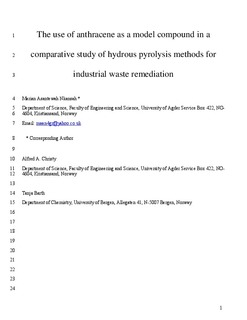The use of anthracene as a model compound in a comparative study of hydrous pyrolysis methods for industrial waste remediation
Journal article, Peer reviewed
Permanent lenke
http://hdl.handle.net/11250/138254Utgivelsesdato
2011Metadata
Vis full innførselSamlinger
Originalversjon
Nkansah, M. A., Christy, A. A., & Barth, T. (2011). The use of anthracene as a model compound in a comparative study of hydrous pyrolysis methods for industrial waste remediation. Chemosphere, 84(4), 403-408.Sammendrag
Polycyclic aromatic hydrocarbons are very stable compounds and tend to bioaccumulate in the environment due to their high degree of conjugation and aromaticity. Hydrous pyrolysis is explored as a technique for the treatment of industrial water containing PAH, using anthracene as a model compound. The reactivity of anthracene under a range of temperatures and durations are studied in this paper. Aliquots of 1.0-10.0mg of anthracene in a range of 1.0-5.0 mL of H(2)O are subjected to hydrous pyrolysis under varied conditions of temperature, reagents and duration. The conditions include oxidising systems comprising distilled water, hydrogen peroxide and Nafion-SiO(2) solid catalyst in water; and reducing systems of formic acid and formic acid/Nafion-SiO(2)/Pd-C catalysts to assess a range of redox reaction conditions. Oxygen in air played a role in some of the reaction conditions. Pyrolysed products were identified and quantified by the use of Gas Chromatography-Mass Spectrometry (GC-MS). The major products were anthrone, anthraquinone, xanthone from oxidation; and multiple hydro-anthracene derivatives from reductive hydogenation. The nature of reaction conditions influenced the extent of anthracene degradation. The products formed are more reactive (less stable) as compared to anthracene the starting material and will therefore be less persistent in the environment.
Beskrivelse
Author's version of an article published in Chemosphere, 84 (4), 403-408. Also available from the publisher: http://dx.doi.org/10.1016/j.chemosphere.2011.03.061
